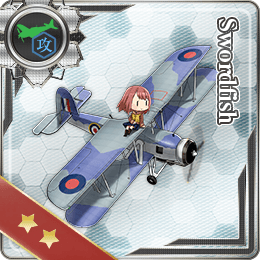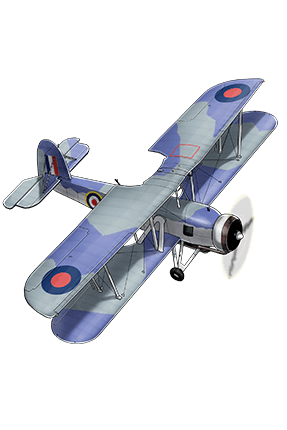[Edit]
Swordfish
No.242 Swordfish
| |
| Refittable Class | |
| Coastal Defense Ship | Destroyer |
| Light Cruiser | Torpedo Cruiser |
| Heavy Cruiser | Training Cruiser |
| Aviation Cruiser | Fast Battleship |
| Battleship | Aviation Battleship |
| Light Carrier | Standard Aircraft Carrier |
| Armored Carrier | Seaplane Tender |
| Submarine | Aircraft Carrying Submarine |
| Submarine Tender | Fleet Oiler |
| Repair Ship | Amphibious Assault Ship |
Introduction
複葉非全金属製の旧世代機でありながら、高い信頼性と運用性を誇る、メカジキの名を持つ紅茶の国の艦上攻撃機。
航空母艦「Ark Royal」搭載の本機は、戦艦「Bismarck」と英艦隊との激闘に大きな一撃を放ちます。旧式ながら赫々たる戦果をおさめた傑作機、遂に実装です!
Although a low speed machine of an older generation with multiple non metallic wings, it boasts high reliability, operability and excellent mobility, serving as offensive aircraft of the country of tea with the name of "Swordfish". The Aircraft Carrier "Ark Royal" loaded with this aircraft against the Battleship "Bismarck" with the British Fleet struck a lethal blow, in an old-fashioned but brilliant fight result, is finally implemented!
Notes
Buildable
- Summer 2017 Event E-1 Hard and E-2 Easy/Normal reward.
- June 2017 Ranking Reward for all tiers.
Improvement
| Improvement Cost: |
★ | S | M | T | W | T | F | S | Helper Ship | ||
|---|---|---|---|---|---|---|---|---|---|---|---|
| Consumes: 1x |
0 | 4/5 | 2/2 | A | A | A | A | A | A | A | Ark Royal (Kai) |
| Consumes: 1x |
6 | 5/9 | 3/5 | ||||||||
| Consumes: 1x 2x Produces: 1x |
10 | 12/18 | 6/9 |
Trivia
A plane more in line with WW1-era aircraft, it was woefully outdated even before the war started. An order was put forth by the British Air Ministry to replace the current Fairey III, and with Fairey's proven track record in creating recon planes, they designed a working prototype by 1933, the TSR I (Torpedo-Spotter-Reconnaissance I). As the name suggests, it was suppose to be an all-in-one aircraft that could be used on both battleships and aircraft carriers for artillery spotting, torpedo bombing (sometimes even dive bombing) and recon. By the time the TSR II was finished, it received its official name, Swordfish, and 68 planes were ordered and designated as Swordfish I in 1936. Though monoplane designs were starting to become the norm with German, Japanese and American navies, Britain curiously decided another biplane series was the way to go. Sporting WW1 armaments and armor that were painfully weak against newer generation aircraft and a top speed of just 150 mph (241 km/h), it seemed that it was doomed at the start of the war. Despite this, its most famous acts were the crippling of battleship Bismarck and the Battle of Taranto but its shortcomings would eventually be highlighted in 1942 when a group of Swordfish were completely wiped out by intercepting Bf 109s, causing its withdraw as a torpedo bomber into a more ASW focused plane. Even as an ASW plane, it pioneered naval use of ASV radar, which helped located Bismarck and hunt submarines in day or night.
- Even if the Swordfish was a biplane, it was not strictly a disadvantage because the design allowed for more tighter agility and acrobatics, sturdier wings and could be constructed with lighter materials due to the naturally strong geometry of the wings structure which in turn allowed it to carry heavier torpedoes. It was also exceptional at carrier takeoffs and landings, which came in real handy when it was relegated to escort carrier use.
- It replaced the Blackburn Baffin, Seal and Shark in 1938, making it the sole torpedo bomber available for 2 years.
- Swordfish I also included a floatplane variant, but these were more vulnerable than their carrier-based counterparts because of their even slower speed due to the weight added by the floats.



